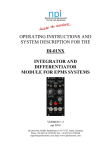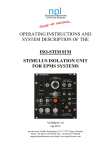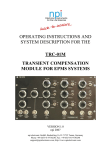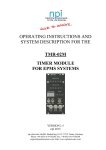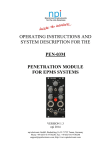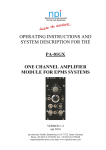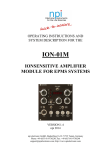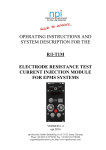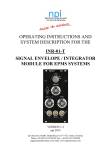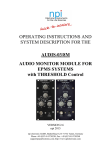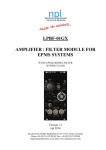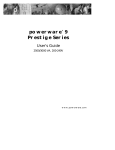Download OPERATING INSTRUCTIONS AND SYSTEM DESCRIPTION FOR
Transcript
OPERATING INSTRUCTIONS AND SYSTEM DESCRIPTION FOR THE WD-01 WINDOW-DISCRIMINATOR MODULE FOR EPMS SYSTEMS VERSION 2.4 npi 2014 npi electronic GmbH, Bauhofring 16, D-71732 Tamm, Germany Phone +49 (0)7141-9730230; Fax: +49 (0)7141-9730240 [email protected]; http://www.npielectronic.com WD-01 User Manual ___________________________________________________________________________ Table of Contents 1. Safety Regulations ............................................................................................................... 3 2. EPMS-07 Modular Plug-In System ..................................................................................... 4 2.1. General System Description / Operation ...................................................................... 4 2.2. EPMS-07 Housing........................................................................................................4 2.3. EPMS-E-07 Housing .................................................................................................... 4 2.4. PWR-03D ..................................................................................................................... 4 2.5. System Grounding ........................................................................................................ 5 EPMS-07 ...................................................................................................................... 5 EPMS-E-07 .................................................................................................................. 5 2.6. Technical Data.............................................................................................................. 5 EPMS-07 ...................................................................................................................... 5 EPMS-E-07 .................................................................................................................. 5 3. WD-01 Window-Discriminator ........................................................................................... 6 3.1. WD-01 Components ..................................................................................................... 6 3.2. System Description ...................................................................................................... 6 3.3. Description of the Front Panel .....................................................................................6 4. Definition of Signals............................................................................................................ 8 5. Function of the Window Discriminator ............................................................................... 9 6. Waveforms in Dependence of the Input Signal (1) ............................................................. 10 7. Waveforms in Dependence of the Input Signal (2) ............................................................. 11 8. Technical Data ..................................................................................................................... 11 ___________________________________________________________________________ version 2.4 page 2 WD-01 User Manual ___________________________________________________________________________ 1. Safety Regulations VERY IMPORTANT: Instruments and components supplied by npi electronic are NOT intended for clinical use or medical purposes (e.g. for diagnosis or treatment of humans), or for any other life-supporting system. npi electronic disclaims any warranties for such purpose. Equipment supplied by npi electronic must be operated only by selected, trained and adequately instructed personnel. For details please consult the GENERAL TERMS OF DELIVERY AND CONDITIONS OF BUSINESS of npi electronic, D-71732 Tamm, Germany. 1) GENERAL: This system is designed for use in scientific laboratories and must be operated only by trained staff. General safety regulations for operating electrical devices should be followed. 2) AC MAINS CONNECTION: While working with the npi systems, always adhere to the appropriate safety measures for handling electronic devices. Before using any device please read manuals and instructions carefully. The device is to be operated only at 115/230 Volt 60/50 Hz AC. Please check for appropriate line voltage before connecting any system to mains. Always use a three-wire line cord and a mains power-plug with a protection contact connected to ground (protective earth). Before opening the cabinet, unplug the instrument. Unplug the instrument when replacing the fuse or changing line voltage. Replace fuse only with an appropriate specified type. 3) STATIC ELECTRICITY: Electronic equipment is sensitive to static discharges. Some devices such as sensor inputs are equipped with very sensitive FET amplifiers, which can be damaged by electrostatic charge and must therefore be handled with care. Electrostatic discharge can be avoided by touching a grounded metal surface when changing or adjusting sensors. Always turn power off when adding or removing modules, connecting or disconnecting sensors, headstages or other components from the instrument or 19” cabinet. 4) TEMPERATURE DRIFT / WARM-UP TIME: All analog electronic systems are sensitive to temperature changes. Therefore, all electronic instruments containing analog circuits should be used only in a warmed-up condition (i.e. after internal temperature has reached steady-state values). In most cases a warm-up period of 20-30 minutes is sufficient. 5) HANDLING: Please protect the device from moisture, heat, radiation and corrosive chemicals. ___________________________________________________________________________ version 2.4 page 3 WD-01 User Manual ___________________________________________________________________________ 2. EPMS-07 Modular Plug-In System 2.1. General System Description / Operation The npi EPMS-07 is a modular system for processing of bioelectrical signals in electrophysiology. The system is housed in a 19” rackmount cabinet (3U) has room for up to 7 plug-in units. The plug-in units are connected to power by a bus at the rear panel. The plug-in units must be kept in position by four screws (M 2,5 x 10). The screws are important not only for mechanical stability but also for proper electrical connection to the system housing. Free area must be protected with covers. 2.2. EPMS-07 Housing The following items are shipped with the EPMS-07 housing: EPMS-07 cabinet with built-in power supply Mains cord Fuse 2 A / 1 A, slow Front covers In order to avoid induction of electromagnetic noise the power supply unit, the power switch and the fuse are located at the rear of the housing. 2.3. EPMS-E-07 Housing The following items are shipped with the EPMS-E-07 housing: EPMS-E-07 cabinet External Power supply PWR-03D Power cord (PWR-03D to EPMS-E-07) Mains chord Fuse 1.6 A / 0.8 A, slow Front covers The EPMS-E-07 housing is designed for low-noise operation, especially for extracellular and multi channel amplifiers with plugged in filters. It operates with an external power supply to minimize distortions of the signals caused by the power supply. 2.4. PWR-03D The external power supply PWR-03D is capable of driving up to 3 EPMS-E housings. Each housing is connected by a 6-pole cable from the one of the three connectors on the front panel of the PWR-03D to the rear panel of the respective EPMS-E housing. (see Figure 1, Figure 3). A POWER LED indicates that the PWR-03D is powered on (see Figure 1). Power switch, voltage selector and fuse are located at the rear panel (see Figure 2). Note: The chassis of the PWR-03D is connected to protective earth, and it provides protective earth to the EPMS-E housing if connected. ___________________________________________________________________________ version 2.4 page 4 WD-01 User Manual ___________________________________________________________________________ Figure 1: PWR-03D front panel view Figure 2: PWR-03D rear panel view Note: This power supply is intended to be used with npi EPMS-E systems only. 2.5. System Grounding EPMS-07 The 19" cabinet is grounded by the power cable through the ground pin of the mains connector (= protective earth). In order to avoid ground loops the internal ground is isolated from the protective earth. The internal ground is used on the BNC connectors or GROUND plugs of the modules that are inserted into the EPMS-07 housing. The internal ground and mains ground (= protective earth) can be connected by a wire using the ground plugs on the rear panel of the instrument. It is not possible to predict whether measurements will be less or more noisy with the internal ground and mains ground connected. We recommend that you try both arrangements to determine the best configuration. EPMS-E-07 The 19" cabinet is connected to the PROTECTIVE EARTH connector at the rear panel. The chassis is linked to protective earth only if the PWR-03D is connected. It can be connected also to the SYSTEM GROUND (SIGNAL GROUND) on the rear panel of the instrument (see Figure 3). Important:: Always adhere to the appropriate safety measures. Figure 3: Rear panel connectors of the EPMS-E-07 2.6. Technical Data 19” rackmount cabinet, for up to 7 plug-in units Dimensions: 3U high (1U=1 3/4” = 44.45 mm), 254 mm deep EPMS-07 Power supply: 115/230 V AC, 60/50 Hz, fuse 2 A / 1 A slow, 45-60 W EPMS-E-07 External power supply (for EPMS-E): 115/230 V AC, 60/50 Hz, fuse 1.6/0.8 A, slow Dimensions of External power supply: (W x D x H) 225 mm x 210 mm x 85 mm ___________________________________________________________________________ version 2.4 page 5 WD-01 User Manual ___________________________________________________________________________ 3. WD-01 Window-Discriminator 3.1. WD-01 Components The following items are shipped with the WD-01 system: Window discriminator module for the EPMS-07 system User manual 3.2. System Description The WD-01 is a plug in modular unit for the detection and recording of specific voltage level pulses in a noisy background. This is achieved by producing a pulse when the signal’s peak is within the lower and upper window levels. The window levels are controlled by ten turn potentiometers and can be adjusted to ± 10 V. Gain selection of x1, x10 , x100, pre-selection for polarity of the peak detection and independent selection of the polarity for lower level and upper level signals are features that complete this instrument for flexible use in several applications. 3.3. Description of the Front Panel Drawing 1: WD-01 front panel view ___________________________________________________________________________ version 2.4 page 6 WD-01 User Manual ___________________________________________________________________________ In the following description of the front panel elements each element has a number that is related to that in Drawing 1. The number is followed by the name (in uppercase letters) written on the front panel and the type of the element (in lowercase letters). Then, a short description of the element is given. (1) PEAK+ / PEAK- switch Switch for selecting the type of peak detection. PPDM: positive detection mode. NPDM: negative detection mode. (2) + / 0 / - switch Switch for selecting the polarity of the UPPER LEVEL. Note that setting the switch to 0 forces the UPPER LEVEL to zero. (3) UPPER LEVEL potentiometer 10-turn potentiometer for setting the value of the UPPER LEVEL. Range: ±10 V. Very important: The UPPER LEVEL is always set by this potentiometer, even if the value set here is less than the value set by the LOWER LEVEL potentiometer. (4) PULSE WIDTH trim pot Trim pot for setting the PULSE WIDTH of the window TTL outputs. Range: 50 µs to 5 ms. (5) ERROR LED LED which lights if the PULSE WIDTH is greater than the width of the INPUT signal. (6) MUX OUTPUT connector BNC connector providing a multiplexed output of the lower level, upper level and amplified input for display on an analog oscilloscope, i.e. this connector provides upper and lower level and the amplified signal simultaneously. WINDOW OUTPUTS TTL (7) IN WINDOW connector BNC connector providing a TTL signal if a signal enters and leaves the window created by the upper and the lower level setting. The levels are detected similar as when using the >upper or >lower connectors, but a TTL is generated only if the positive peak of signal is within the windows created by the upper and the lower level (PPDM), or if the negative peak of signal is within the windows created by the upper and the lower level (NPDM). (8) >UPPER connector PPDM: BNC connector providing a TTL signal if a signal goes more positive than the upper level. NPDM: BNC connector providing a TTL signal if a signal goes more negative than the upper level. ___________________________________________________________________________ version 2.4 page 7 WD-01 User Manual ___________________________________________________________________________ (9) >LOWER connector PPDM: BNC connector providing a TTL signal if a signal goes more positive than the lower level. NPDM: BNC connector providing a TTL signal if a signal goes more negative than the lower level. (10) INPUT connector BNC connector for the INPUT signal. Range: ±10 V. Important: The signal is amplified by the factor set by the GAIN switch. The amplified signal must not exceed ±10 V! (11) GAIN switch Switch to set the GAIN for the INPUT signal (x1, x10 or x100). (12) LOWER LEVEL potentiometer 10-turn potentiometer for setting the value of the LOWER LEVEL. Range: ±10 V. Very important: The LOWER LEVEL is always set by this potentiometer, even if the value set here is greater than the value set by the UPPER LEVEL potentiometer. (13) + / 0 / - switch Switch for selecting the polarity of the LOWER LEVEL. Note that setting the switch to 0 forces the LOWER LEVEL to zero. 4. Definition of Signals PPD: NPD: positive peak detection negative peak detection >LOWER: TTL output when the input signal is higher then lower level (PPD) TTL output when the input signal is lower then lower level (NPD) >UPPER: TTL output when the input signal is higher then upper level (PPD) TTL output BNC when the input signal is lower then upper level (NPD) ___________________________________________________________________________ version 2.4 page 8 WD-01 User Manual ___________________________________________________________________________ IN WINDOW: TTL output when the input signal is higher then lower level or lower then lower level without going higher then upper level. The pulse occurs when the input signal is leaves the window. (See also fig. 2 and fig. 3 for more clarification) PULSE WIDTH: this trim pot controls the width of the TTL pulses provided at the window outputs. The variation is possible between 50 µs and 5 ms. ERROR LED: this LED will light if the pulse width of the TTL outputs is wider than the incoming signal. For instance in figure 2 at 2.a the >LOWER output will not create a pulse (or will produce a long pulse) if the pulse width is too wide. However, in figure 3 the pulse width has been reduced and the pulses are correct. In this case the ERROR LED will not light. Note: The pulse width of the TTL outputs (i.e. >LOWER) must be at least 3 times quicker than the fastest signal to be measured. 5. Function of the Window Discriminator IN WINDOW: this output will produce a pulse if the signal crosses the lower level and then exits the window again through the lower level without first crossing the upper level . This is valid for PPD and NPD-mode. MUX output: this is a multiplexer output. The selected lower and upper levels and the amplified input signal are time multiplexed to produce a multi signal voltage output which can be displayed on any analog oscilloscope. (The multiplexed signal can also be read on a digital oscilloscope, however, this method is noisy and difficult to read.) ___________________________________________________________________________ version 2.4 page 9 WD-01 User Manual ___________________________________________________________________________ 6. Waveforms in Dependence of the Input Signal (1) ___________________________________________________________________________ version 2.4 page 10 WD-01 User Manual ___________________________________________________________________________ 7. Waveforms in Dependence of the Input Signal (2) 8. Technical Data Electrical Data Input resistance: Output impedance: 1 M 250 Input range: Input amplification: Output voltage range: Window level range: ±10 V x1, x10, x100 ±10 V ±10 V Signal >LOWER; >UPPER; IN WINDOW: TTL compatible pulses (3-5V), pulse width adjustable between 0.05 ms and 5 ms. Impedance of TTL signal outputs: <500. Delay time multiplexed output: signal on time 18 s (60%). Lower & Upper levels 6s (20%) each Error detection: LED light duration 1 s ___________________________________________________________________________ version 2.4 page 11











